Public Attitudes toward Renewable Energy in Croatia
Abstract
:1. Introduction
2. Renewable Energy—EU and Croatian Context
2.1. EU and Croatian Legal and Policy Context
2.2. Renewable Energy Sector in Croatia in 2009–2019
3. Methods
4. Results
5. Conclusions
Author Contributions
Funding
Data Availability Statement
Conflicts of Interest
Appendix A
| Variable | Question/Statement | Values in the Survey |
|---|---|---|
| Gender | Gender | 1—Female, 2—Male |
| Age | Age | Open question |
| Education | Highest education level | 1—Secondary education or lower, 2—Tertiary education, 3—Post-graduate education |
| County | County of residence | 1—Bjelovar-Bilogora County, 2—Brod-Posavina County, 3—Dubrovnik-Neretva County, 4—Istria County, 5—Karlovac County, 6—Koprivnica-Križevci County, 7—Krapinska-Zagorje County, 8—Lika-Senj County, 9—Međimurje County, 10—Osijek-Baranja County, 11—Požega-Slavonia County, 12—Primorje-Gorski Kotar County, 13—Sisak-Moslavina County, 14—Split-Dalmatia County, 15—Šibenik-Knin County, 16—Varaždin County, 17—Virovitica-Podravina County, 18—Vukovar-Srijem County, 19—Zadar County, 20—Zagreb County, 21—City of Zagreb |
| Employment | Employment status | 1—Employed, 2—Student, 3—Other (retired, unemployed) |
| Type of residence facility | Please indicate the type of residence facility in which are you currently living | 1—House, 2—Apartment in the house, 3—Multi-family building |
| Knowledge about renewable energy sources (RES) | Please estimate the level of your knowledge about RES: wind power | 1—Nothing at all, 2—Poor, 3—Average, 4—Good, 5—Excellent |
| Please estimate the level of your knowledge about RES: solar power | ||
| Please estimate the level of your knowledge about RES: hydropower | ||
| Please estimate the level of your knowledge about RES: geothermal energy | ||
| Please estimate the level of your knowledge about RES: biomass | ||
| Use of RES | Do you use any RES in your household | 1—Yes, 2—No |
| Combating climate change | Are you taking measures and actions to mitigate/combat climate change? | 1—Yes, 2—No |
| Impacts of RES | Please indicate to what extent do you agree with the following statement: Increased use of RES has a positive impact on economic development | 1—Strongly disagree, 2—Disagree, 3—Neutral, 4—Agree, 5—Strongly agree |
| Please indicate to what extent you agree with the following statement: Increased use of RES leads to increased employment | ||
| Please indicate to what extent you agree with the following statement: Increased use of RES has the effect of reducing air/water pollution | ||
| Please indicate to what extent you agree with the following statement: Increased use of RES is reducing Croatia’s dependence on energy imports | ||
| Please indicate to what extent you agree with the following statement: Increasing the use of RES affects the increase in energy costs in the household | ||
| Please indicate to what extent you agree with the following statement: Increased use of RES has the effect of mitigating climate change | ||
| Please indicate to what extent you agree with the following statement: Increased use of RES has a positive effect on health | ||
| Please indicate to what extent you agree with the following statement: The economic benefits of introducing RES in households are great | ||
| Please indicate to what extent you agree with the following statement: The economic benefits of introducing RES for the municipality/city in which I live are great | ||
| Willingness to pay | How much extra would you be willing to pay to buy electricity from renewable sources? | 1—EUR 0, 2—from EUR 0.1 to 6.6, 3—from EUR 6.7 to 13.3, 4—more than EUR 13.3.Amounts are recalculated from HRK to EUR according to the Croatian National Bank exchange rate for 2020: 1 EUR = 7.53308 HRK |
| Willingness to purchase green energy from local supplier | If your local electricity supplier offered clean, renewable energy, would you buy it? | 1—Yes, 2—No |
| Willingness to install renewable energy technology with subsidized costs | If there was a possibility of subsidizing RES, would you decide to install a solar panel or other renewable energy sources in the yard or on the roof of the house or building in which you live? | 1—Yes, 2—No |
| Trust in local government | Please indicate to what extent you agree with each of the following statements: I have confidence that the municipality/city in which I live takes measures for the benefit of citizens in the field of energy and climate policy | 1—Strongly disagree, 2—Disagree, 3—Neutral, 4—Agree, 5—Strongly agree |
References
- International Panel on Climate Change. Global Warming of 1.5 °C. An IPCC Special Report on the Impacts of Global Warming of 1.5 °C above Pre-Industrial Levels and Related Global Greenhouse Gas Emission Pathways, in the Context of Strengthening the Global Response to the Threat of Climate Change, Sustainable Development, and Efforts to Eradicate Poverty, World Meteorological Organization, Geneva, Switzerland 2018. Available online: https://www.ipcc.ch/sr15/ (accessed on 26 November 2021).
- The Paris Agreement|UNFCCC. Available online: https://unfccc.int/sites/default/files/english_paris_agreement.pdf (accessed on 4 October 2021).
- Oberthür, S.; Claire Roche Kelly, C. EU Leadership in International Climate Policy: Achiements and Challenges. Int. Spect. 2008, 43, 35–50. [Google Scholar] [CrossRef]
- Lütz, S.; Leeg, T.; Otto, D.; Woyames Dreher, V. Climate Policy. In The European Union as a Global Actor; Springer: Cham, Switzerland, 2021. [Google Scholar] [CrossRef]
- European Commission. A Clean Planet for all A European Strategic Long-Term Vision for a Prosperous, Modern, Competitive and Climate Neutral Economy; European Commission COM (2018) 773 final: Brussels, Belgium, 2018. [Google Scholar]
- European Commission. Directive 2009/28/EC of the European Parliament and of the Council of 23 April 2009 on the promotion of the use of energy from renewable sources and amending and subsequently repealing Directives 2001/77/EC and 2003/30/EC. Off. J. Eur. Union 2009, L140, 1–148. [Google Scholar]
- Eurostat. Energy Statistics. Available online: https://ec.europa.eu/eurostat/web/energy/data/shares (accessed on 20 October 2021).
- Kitzing, L.; Mitchell, C.; Morthorst, P.E. Renewable energy policies in Europe: Converging or diverging? Energy Policy 2012, 51, 192–201. [Google Scholar] [CrossRef] [Green Version]
- Tvinnereim, E.; Lægreidb, O.M.; Fløttum, K. Who cares about Norway’s energy transition? A survey experiment about citizen associations and petroleum. Energy Res. Soc. Sci. 2020, 62, 101357. [Google Scholar] [CrossRef]
- Vainio, A.; Varho, V.; Tapio, P.; Pulkka, A.; Paloniemi, R. Citizens’ images of a sustainable energy transition. Energy 2019, 183, 606–616. [Google Scholar] [CrossRef]
- Yue, X.; Patankar, N.; Decarolis, J.; Chiodi, A.; Rogan, F.; Deane, J.P.; O’Gallachoir, B. Least cost energy system pathways towards 100% renewable energy in Ireland by 2050. Energy 2020, 207, 118264. [Google Scholar] [CrossRef] [PubMed]
- Hoicka, C.E.; Lowitzsch, J.; Brisbois, M.C.; Kumar, A.; Camargo, L.R. Implementing a just renewable energy transition: Policy advice for transposing the new European rules for renewable energy communities. Energy Policy 2021, 156, 112435. [Google Scholar] [CrossRef]
- Bednarczyk, J.L.; Brzozowska-Rup, K.; Luściński, S. Determinants of the Energy Development Based on Renewable Energy Sources in Poland. Energies 2021, 14, 6762. [Google Scholar] [CrossRef]
- European Commission. Renewable Energy in Europe. Available online: https://ec.europa.eu/info/sites/default/files/energy_climate_change_environment/events/documents/in_focus_renewable_energy_in_europe_en.pdf (accessed on 2 October 2021).
- Jenniches, S. Assessing the regional economic impacts of renewable energy sources—A literature review. Renew. Sustain. Energy Rev. 2018, 93, 35–51. [Google Scholar] [CrossRef]
- Bulavskaya, T.; Reynès, F. Job creation and economic impact of renewable energy in the Netherlands. Renew. Energy 2018, 119, 528–538. [Google Scholar] [CrossRef] [Green Version]
- Kelsey, N.; Meckling, J. Who wins in renewable energy? Evidence from Europe and the United States. Energy Res. Soc. Sci. 2018, 37, 65–73. [Google Scholar] [CrossRef]
- Inglesi-Lotz, R. The impact of renewable energy consumption to economic growth: A panel data application. Energy Econ. 2016, 53, 58–63. [Google Scholar] [CrossRef] [Green Version]
- Moreno, B.; López, A.J. The effect of renewable energy on employment. The case of Asturias (Spain). Renew. Sustain. Energy Rev. 2008, 12, 732–751. [Google Scholar] [CrossRef]
- Lehr, U.; Nitsch, J.; Kratzat, M.; Lutz, C.; Edler, D. Renewable energy and employment in Germany. Energy Policy 2008, 36, 108–117. [Google Scholar] [CrossRef]
- Alper, A.; Oguz, O. The role of renewable energy consumption in economic growth: Evidence from asymmetric causality. Renew. Sustain. Energy Rev. 2016, 60, 953–959. [Google Scholar] [CrossRef]
- Yumashev, A.; Ślusarczyk, B.; Kondrashev, S.; Mikhaylov, A. Global Indicators of Sustainable Development: Evaluation of the Influence of the Human Development Index on Consumption and Quality of Energy. Energies 2020, 13, 2768. [Google Scholar] [CrossRef]
- Wang, Z.; Zhang, B.; Wang, B. Renewable energy consumption, economic growth and human development index in Pakistan: Evidence form simultaneous equation model. J. Clean. Prod. 2018, 184, 1081–1090. [Google Scholar] [CrossRef]
- Hatefi, S.M.; Torabi, S.A. A slack analysis framework for improving composite indicators with applications to human development and sustainable energy indices. Econom. Rev. 2018, 37, 247–259. [Google Scholar] [CrossRef]
- Ray, M. Redefining the Human Development Index to Account for Sustainability. Atlatnic Econ. J. 2014, 42, 305–316. [Google Scholar] [CrossRef]
- Martínez-Guido, S.I.; González-Campos, J.B.; Ponce-Ortega, J.M. Strategic planning to improve the Human Development Index in disenfranchised communities through satisfying food, water and energy needs. Food Bioprod. Process. 2019, 117, 14–29. [Google Scholar] [CrossRef]
- Del Río, P.; Burguillo, M. An empirical analysis of the impact of renewable energy deployment on local sustainability. Renew. Sustain. Energy Rev. 2009, 13, 1314–1325. [Google Scholar] [CrossRef]
- Saidi, K.; Omri, A. The impact of renewable energy on carbon emissions and economic growth in 15 major renewable energy-consuming countries. Environ. Res. 2020, 186, 109567. [Google Scholar] [CrossRef]
- Ntanos, S.; Kyriakopoulos, G.; Chalikias, M.; Arabatzis, G.; Skordoulis, M.; Galatsidas, S.; Drosos, D. A Social Assessment of the Usage of Renewable Energy Sources and Its Contribution to Life Quality: The Case of an Attica Urban Area in Greece. Sustainability 2018, 10, 1414. [Google Scholar] [CrossRef] [Green Version]
- Haseeb, M.; Kot, S.; Hussain, H.I.; Jermsittiparsert, K. Impact of Economic Growth, Environmental Pollution, and Energy Consumption on Health Expenditure and R&D Expenditure of ASEAN Countries. Energies 2019, 12, 3598. [Google Scholar]
- Koçak, E.; Sarkgünesi, A. The renewable energy and economic growth nexus in Black Sea and Balkan countries. Energy Policy 2017, 100, 51–57. [Google Scholar] [CrossRef]
- Karlstrøm, H.; Ryghaug, M. Public attitudes towards renewable energy technologies in Norway. The role of party preferences. Energy Policy 2014, 67, 656–663. [Google Scholar] [CrossRef] [Green Version]
- Kalkbrenner, B.J.; Roosen, J. Citizens’ willingness to participate in local renewable energy projects: The role of community and trust in Germany. Energy Res. Soc. Sci. 2016, 13, 60–70. [Google Scholar] [CrossRef]
- Noblet, C.L.; Teisl, M.F.; Evans, K.; Anderson, M.W.; McCoy, S.; Cervone, E. Public preferences for investments in renewable energy production and energy efficiency. Energy Policy 2015, 87, 177–186. [Google Scholar] [CrossRef] [Green Version]
- Karytsas, S.; Theodoropoulou, H. Socioeconomic and Demographic Factors That Influence Publics’ Awareness On the Different Forms of Renewable Energy Sources. Renew. Energy 2014, 71, 480–485. [Google Scholar] [CrossRef]
- Brennan, N.; van Rensburg, T.M. Public preferences for wind farms involving electricity trade and citizen engagement in Ireland. Energy Policy 2020, 147, 111872. [Google Scholar] [CrossRef]
- Salak, B.; Lindberg, K.; Kienast, F.; Hunziker, M. How landscape-technology fit affects public evaluations of renewable energy infrastructure scenarios. A hybrid choice model. Renew. Sustain. Energy Rev. 2021, 143, 110896. [Google Scholar] [CrossRef]
- Gryz, J.; Kaczmarczyk, B. Toward Low-Carbon European Union Society: Young Poles’ Perception of Climate Neutrality. Energies 2021, 14, 5107. [Google Scholar] [CrossRef]
- Szakály, Z.; Balogh, P.; Kontor, E.; Gabnai, Z.; Bai, A. Attitude toward and Awareness of Renewable Energy Sources: Hungarian Experience and Special Features. Energies 2021, 14, 22. [Google Scholar] [CrossRef]
- Pons-Seres de Brauwer, C.; Cohen, J.J. Analysing the potential of citizen-financed community renewable energy to drive Europe’s low-carbon energy transition. Renew. Sustain. Energy Rev. 2020, 133, 110300. [Google Scholar] [CrossRef]
- Horstink, L.; Wittmayer, J.M.; Ng, K. Pluralising the European energy landscape: Collective renewable energy prosumers and the EU’s clean energy vision. Energy Policy 2021, 153, 112262. [Google Scholar] [CrossRef]
- Soeiro, S.; Ferreira Dias, M. Renewable energy community and the European energy market: Main motivations. Heliyon 2020, 6, e04511. [Google Scholar] [CrossRef]
- Horstink, L.; Wittmayer, J.M.; Ng, K.; Pontes Luz, G.; Marín-González, E.; Gährs, S.; Campos, I.; Holstenkamp, L.; Oxenaar, S.; Brown, D. Collective Renewable Energy Prosumers and the Promises of the Energy Union: Taking Stock. Energies 2020, 13, 421. [Google Scholar] [CrossRef] [Green Version]
- Žiković, S.; Gržeta, I.; Tomas Žiković, I. Empirical analysis of wind power generation profitability in Croatia. In The 4th International Scientific Conference Economy of Eastern Croatia—Visions and Development, Osijek, Croatia; Mašek Tonković, A., Ed.; Sveučilište Josipa Jurja Strossmayera u Osijeku, Ekonomski fakultet u Osijeku: Osijek, Croatia, 2015; pp. 537–546. [Google Scholar]
- Ognjan, D.; Stanić, Z.; Tomšić, Ž. Isplativost poticajne otkupne cijene za projekte vjetroelektrana u Republici Hrvatskoj. Energija 2008, 57, 178–199. [Google Scholar]
- Lugarić, L.; Krajcar, S.; Ćurković, A. Analiza financijskog rizika u vrednovanju projekata izgradnje vjetroelektrana. Energija 2007, 56, 346–373. [Google Scholar]
- Mikulić, D.; Lovrinčević, Ž.; Keček, D. 2018, Economic Effects of Wind Power Plant Deployment on the Croatian Economy. Energies 2018, 11, 1881. [Google Scholar] [CrossRef] [Green Version]
- Runko Luttenberger, L. The barriers to renewable energy use in Croatia. Renew. Sustain. Energy Rev. 2015, 49, 646–654. [Google Scholar] [CrossRef]
- Jelavić, B.; Domac, J.; Horvath, L. Obnovljivi izvori energije u Republici Hrvatskoj s naglaskom na energiju biomase i vjetra. Naft. Znan. Stručno Glas. Hrvat. Udruge Naft. Inženjera I Geol. 2007, 31, 35–47. [Google Scholar]
- Keček, D.; Mikulić, D.; Lovrinčević, Ž. Deployment of renewable energy: Economic effects on the Croatian economy. Energy Policy 2019, 126, 402–410. [Google Scholar] [CrossRef]
- Car, S.; Mađerčić, M. Obnovljivi izvori energije i gospodarski razvoj. Elektroenergetika 2006, 3, 24–30. [Google Scholar]
- Šimurina, N.; Čeh Časni, A.; Jelić, H. Utjecaj energetskih poreza na potražnju za obnovljivim izvorima energije—panel analiza. In Proceedings of the International Conference on the Economics of Decoupling (ICED), Zagreb, Croatia, 2–3 December 2019; Družić, G., Gelo, T., Eds.; Croatian Academy of Sciences and Arts, Faculty of Economics and Business University of Zagreb: Zagreb, Croatia, 2020; pp. 193–210. [Google Scholar]
- Lovrinčević, Ž. Jesu li proizvođači energije iz obnovljivih izvora profitabilni u Hrvatskoj? In Proceedings of the Polytechnic of Šibenik, 4th International Conference, the Challenges of Today, Šibenik, Croatia, 10–12 October 2019; Filiposki, O., Metodijeski, D., Zlatović, D., Eds.; Polytechnic of Šibenik: Šibenik, Croatia, 2019; pp. 421–431. [Google Scholar]
- Božičević, M.; Jakšić, D.; Kovačevic, T. Zeleni certifikati: Tržišni mehanizam potpore obnovljivim izvorima energije. Energija 2003, 52, 207–212. [Google Scholar]
- Domac, J.; Kufrin, K.; Šegon, V. Obnovljivi izvori energije i energetska efikasnost. Stavovi i mišljenja stanovnika Zagreba i Rijeke. Soc. Ekol. 2004, 13, 347–364. [Google Scholar]
- Kufrin, K.; Domac, J.; Šegon, V. Informiranost o obnovljivim izvorima energije i energetskoj efikasnosti. Soc. Ekol. Časopis Za Ekološku Misao Sociol. Istraživanja Okoline 2004, 13, 325–346. [Google Scholar]
- Wüstenhagen, R.; Wolsink, M.; Bürer, M.J. Social acceptance of renewable energy innovation: An introduction to the concept. Energy Policy 2007, 35, 2683–2691. [Google Scholar] [CrossRef] [Green Version]
- European Commission. COM(2019) 640 Final Communication from the Commission to the European Parliament, the European Council, the Council, the European Economic and Social Committee and the Committee of the Regions—The European Green Deal. 2019. Available online: https://eur-lex.europa.eu/legal-content/EN/TXT/?qid=1576150542719&uri=COM%3A2019%3A640%3AFIN (accessed on 30 September 2021).
- European Commission. Di rective 2018/2001 of the European Parliament and of the Council of 11 December 2018 on the promotion of the use of energy from renewable sources. Off. J. Eur. Union 2018, L328, 82–209. [Google Scholar]
- European Commission. Commission Implementing Regulation (EU) 2020/1294 of 15 September 2020 on the Union Renewable Energy Financing Mechanism (Text with EEA Relevance). Available online: http://data.europa.eu/eli/reg_impl/2020/1294/oj/eng (accessed on 21 October 2021).
- Energy Strategy of the Republic of Croatia Until 2030, with a View to 2050. Official Gazette 25/2020. Available online: https://narodne-novine.nn.hr/clanci/sluzbeni/2020_03_25_602.html (accessed on 5 October 2021).
- National Renewable Energy Action Plans 2020. Available online: https://ec.europa.eu/energy/topics/renewable-energy/directive-targets-and-rules/national-renewable-energy-action-plans-2020_en (accessed on 5 October 2021).
- Low-Carbon Development Strategy of the Republic of Croatia until 2030 with a View to 2050. Official Gazette 63/2021. Available online: https://narodne-novine.nn.hr/clanci/sluzbeni/2021_06_63_1205.html (accessed on 5 October 2021).
- Regulation Amending the Regulation Establishing a Guarantee of Origin of Electricity. Official Gazette 55/2019. Available online: https://narodne-novine.nn.hr/clanci/sluzbeni/2019_05_55_1046.html (accessed on 12 October 2021).
- Integrated National Energy and Climate Plan for the Republic of Croatia for the Period 2021–2030. Available online: https://mingor.gov.hr/UserDocsImages/UPRAVA%20ZA%20ENERGETIKU/Strategije,%20planovi%20i%20programi/NECP_Croatia_eng.pdf (accessed on 1 October 2021).
- Act on Energy. Official Gazette 120/2012. Available online: https://narodne-novine.nn.hr/clanci/sluzbeni/2012_10_120_2583.html (accessed on 18 October 2021).
- Act on Electrical Energy Market. Official Gazette 111/2021. Available online: https://narodne-novine.nn.hr/clanci/sluzbeni/2021_10_111_1940.html (accessed on 18 October 2021).
- Act on Renewable Energy Sources and High Efficiency Cogeneration. Official Gazette 100/2015, 111/2018. Available online: https://narodne-novine.nn.hr/clanci/sluzbeni/2018_12_111_2151.html (accessed on 18 October 2021).
- Matell, M.; Jacoby, J. Is There an Optimal Number of Alternatives for Likert-scale Items? Effects of Testing Time and Scale Properties. J. Appl. Psychol. 1972, 56, 506–509. [Google Scholar] [CrossRef] [Green Version]
- Dlamini, S.; Tesfamichael, S.G.; Tholang Mokhele, T. Socio-demographic determinants of environmental attitudes, perceptions, place attachment, and environmentally responsible behaviour in Gauteng province, South Africa. Sci. Afr. 2021, 12, e00772. [Google Scholar] [CrossRef]
- Kollmuss, A.; Agyeman, J. Mind the Gap: Why do people act environmentally and what are the barriers to pro-environmental behavior? Environ. Educ. Res. 2002, 8, 239–260. [Google Scholar] [CrossRef] [Green Version]
- Chen, X.; Peterson, M.; HULL, V.; Lu, C.; Lee, G.; Hong, D.; Liu, J. Effects of attitudinal and sociodemographic factors on pro-environmental behaviour in urban China. Environ. Conserv. 2011, 38, 45–52. [Google Scholar] [CrossRef] [Green Version]
- Masud, M.M.; Akhatr, R.; Nasrin, S.; Adamu, I.M. Impact of socio-demographic factors on the mitigating actions for climate change: A path analysis with mediating effects of attitudinal variables. Environ. Sci. Pollut. Res. 2017, 24, 26462–26477. [Google Scholar] [CrossRef] [PubMed]
- Mcgowan, F.; Sauter, R. 2005 Public Opinion on Energy Research: A Desk Study for the Research Councils. Available online: https://epsrc.ukri.org/newsevents/pubs/public-opinion-on-energy-research-a-desk-study-for-the-research-councils/ (accessed on 20 October 2021).
- Tranter, B. Political divisions over climate change and environmental issues in Australia. Environ. Polit. 2011, 20, 78–96. [Google Scholar] [CrossRef]
- Pašičko, R.; Branković, Č.; Šimić, Z. Assessment of climate change impacts on energy generation from renewable sources in Croatia. Renew. Energy 2012, 46, 224–231. [Google Scholar] [CrossRef]
- Yang, Z.; Wang, X.; Su, C. A review of research methodologies in international business. Int. Bus. Rev. 2006, 15, 601–617. [Google Scholar] [CrossRef]
- Shih, T.-H.; Fan, X. Comparing response rates in e-mail and paper surveys: A meta-analysis. Educ. Res. Rev. 2009, 4, 26–40. [Google Scholar] [CrossRef]
- Curtin, R.; Presser, S.; Singer, E. The Effect of Response Rate Changes on the Index of Consumer Sentiment. Public Opin. Q. 2000, 64, 413–428. [Google Scholar] [CrossRef] [PubMed] [Green Version]
- Meterko, M.; Restuccia, J.D.; Stolzmann, K.; Mohr, D.; Brennan, C.; Glasgow, J.; Kaboli, P. Response Rates, Nonresponse Bias, and Data Quality: Results from a National Survey of Senior Healthcare Leaders. Public Opin. Q. 2015, 79, 130–144. [Google Scholar] [CrossRef] [Green Version]
- Limesurvey GmbH./LimeSurvey: An Open Source Survey Tool/LimeSurvey GmbH, Hamburg, Germany. Available online: http://www.limesurvey.org (accessed on 26 November 2021).
- Ntanos, S.; Kyriakopoulos, G.; Chalikias, M.; Arabatzis, G.; Skordoulis, M. Public Perceptions and Willingness to Pay for Renewable Energy: A Case Study from Greece. Sustainability 2018, 10, 687. [Google Scholar] [CrossRef] [Green Version]
- Piekut, M. The Consumption of Renewable Energy Sources (RES) by the European Union Households between 2004 and 2019. Energies 2021, 14, 5560. [Google Scholar] [CrossRef]
- Zoellner, J.; Schweizer-Ries, P.; Wemheuer, C. Public acceptance of renewable energies: Results from case studies in Germany. Energy Policy 2008, 36, 4136–4141. [Google Scholar] [CrossRef]
- Dietz, T.; Stern, P.C.; Guagnano, G.A. Social structural and social psychological bases of environmental concern. Environ. Behav. 1998, 30, 450–471. [Google Scholar] [CrossRef] [Green Version]
- Zelezny, L.C.; Chua, P.-P.; Aldrich, C. Elaborating on gender differences in environmentalism. J. Soc. Issues 2000, 56, 443–457. [Google Scholar] [CrossRef]
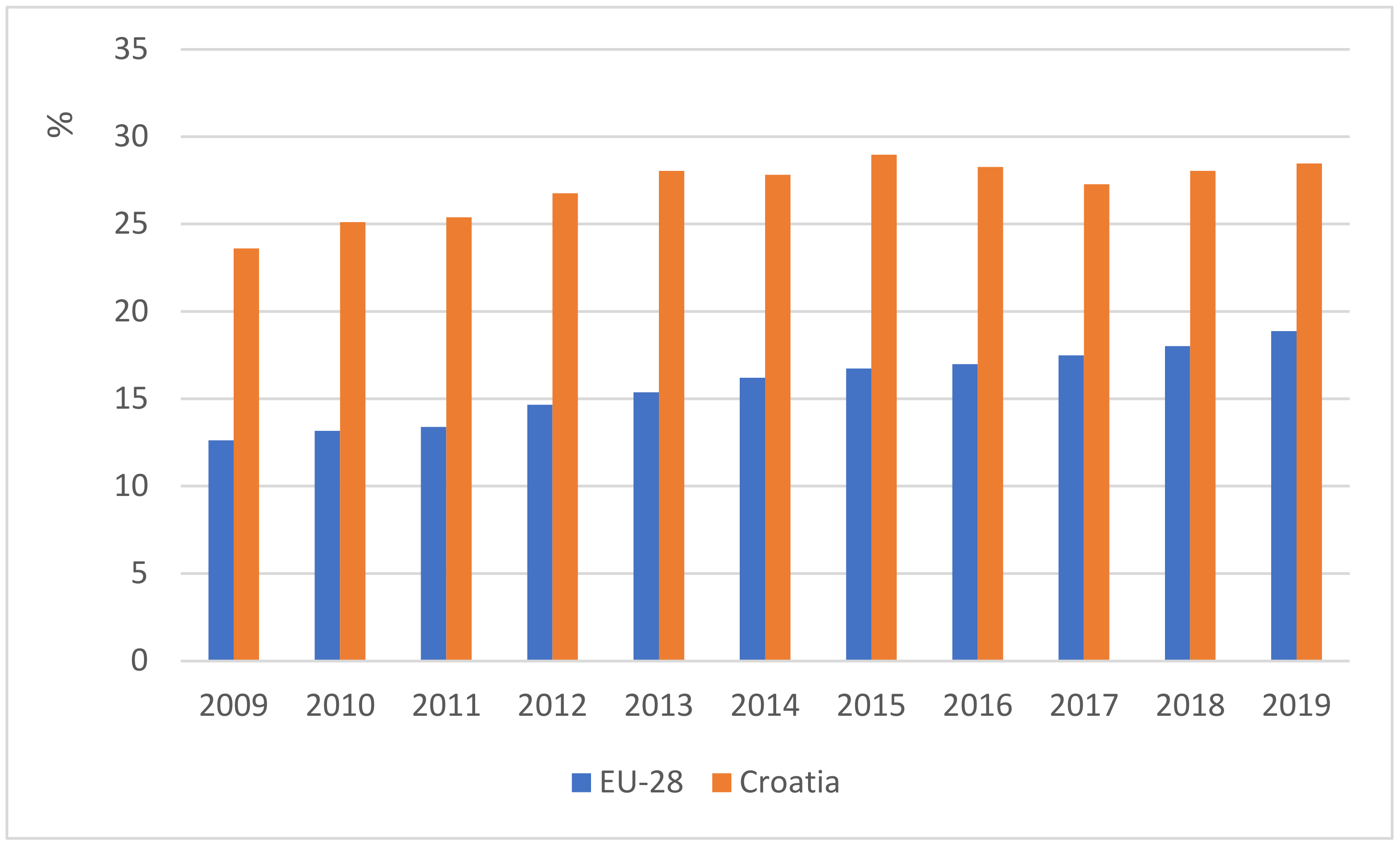
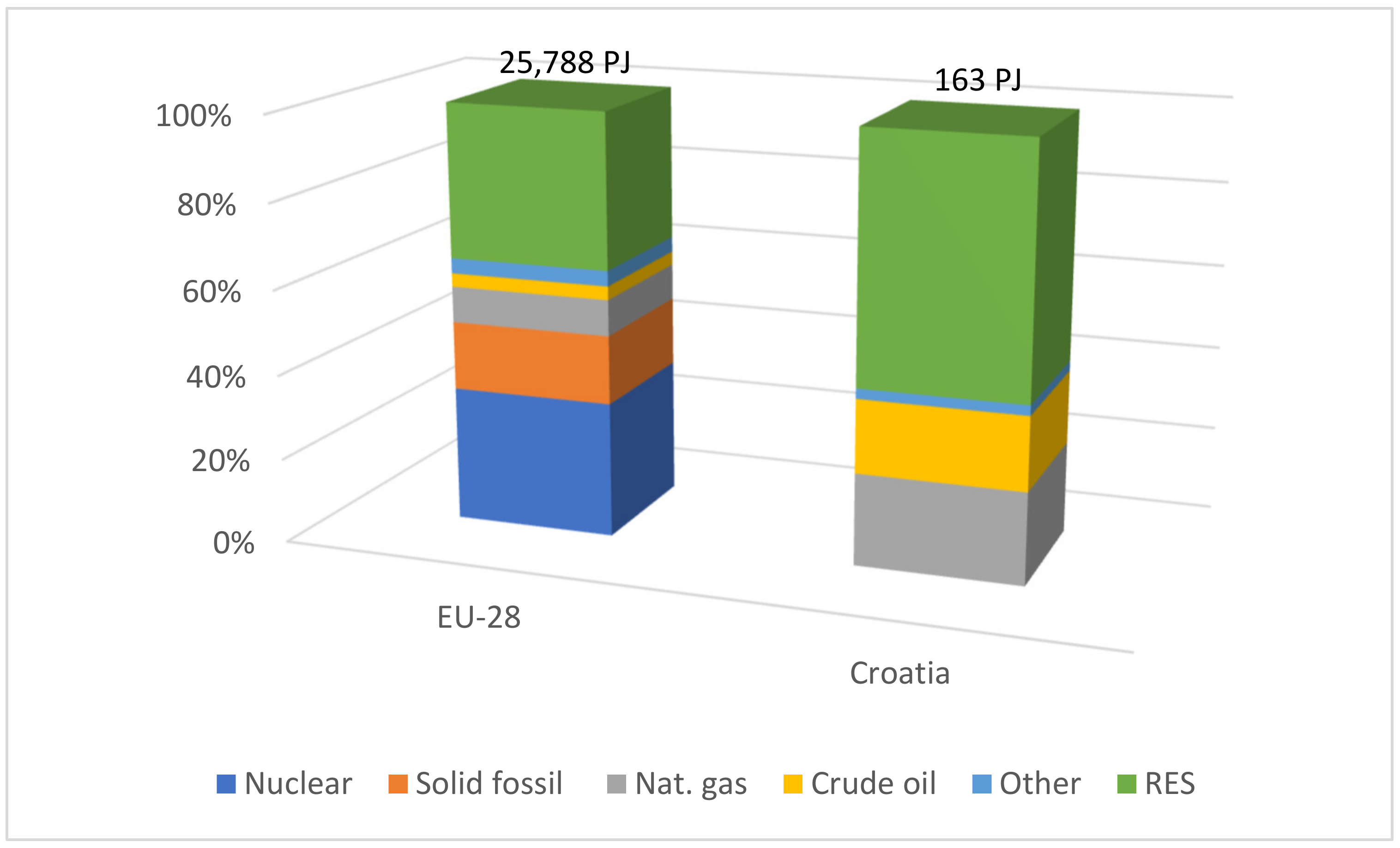
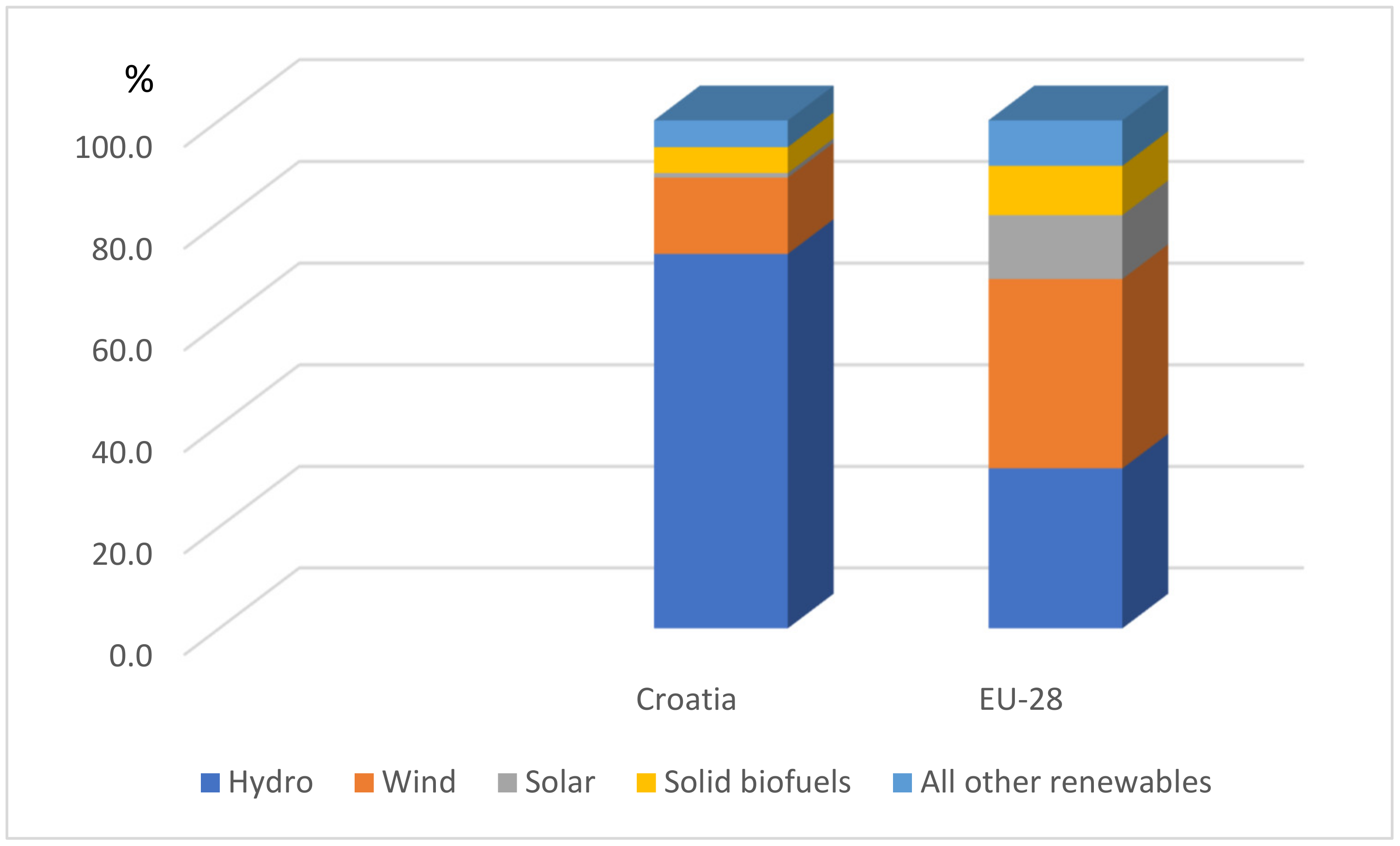
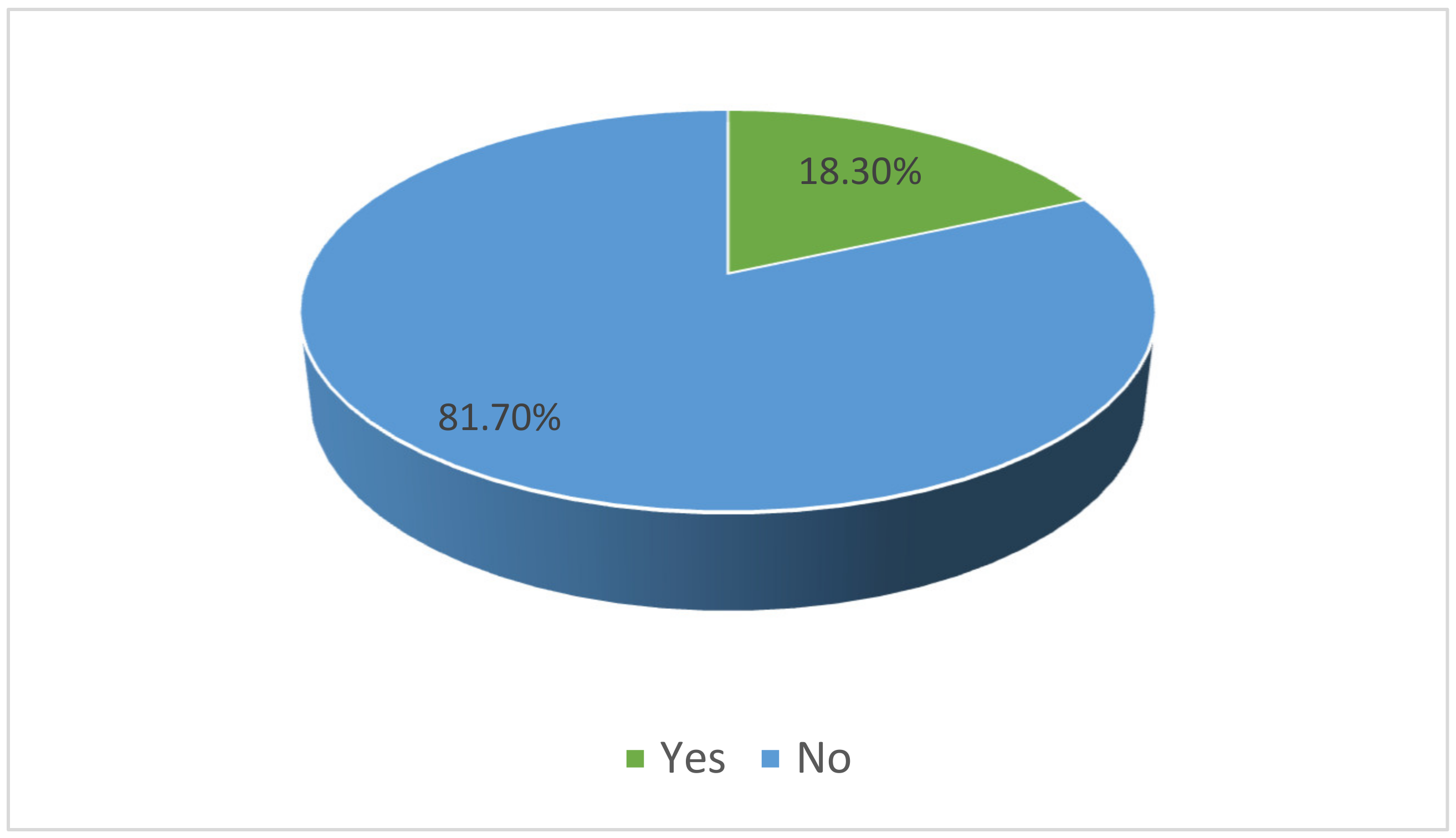
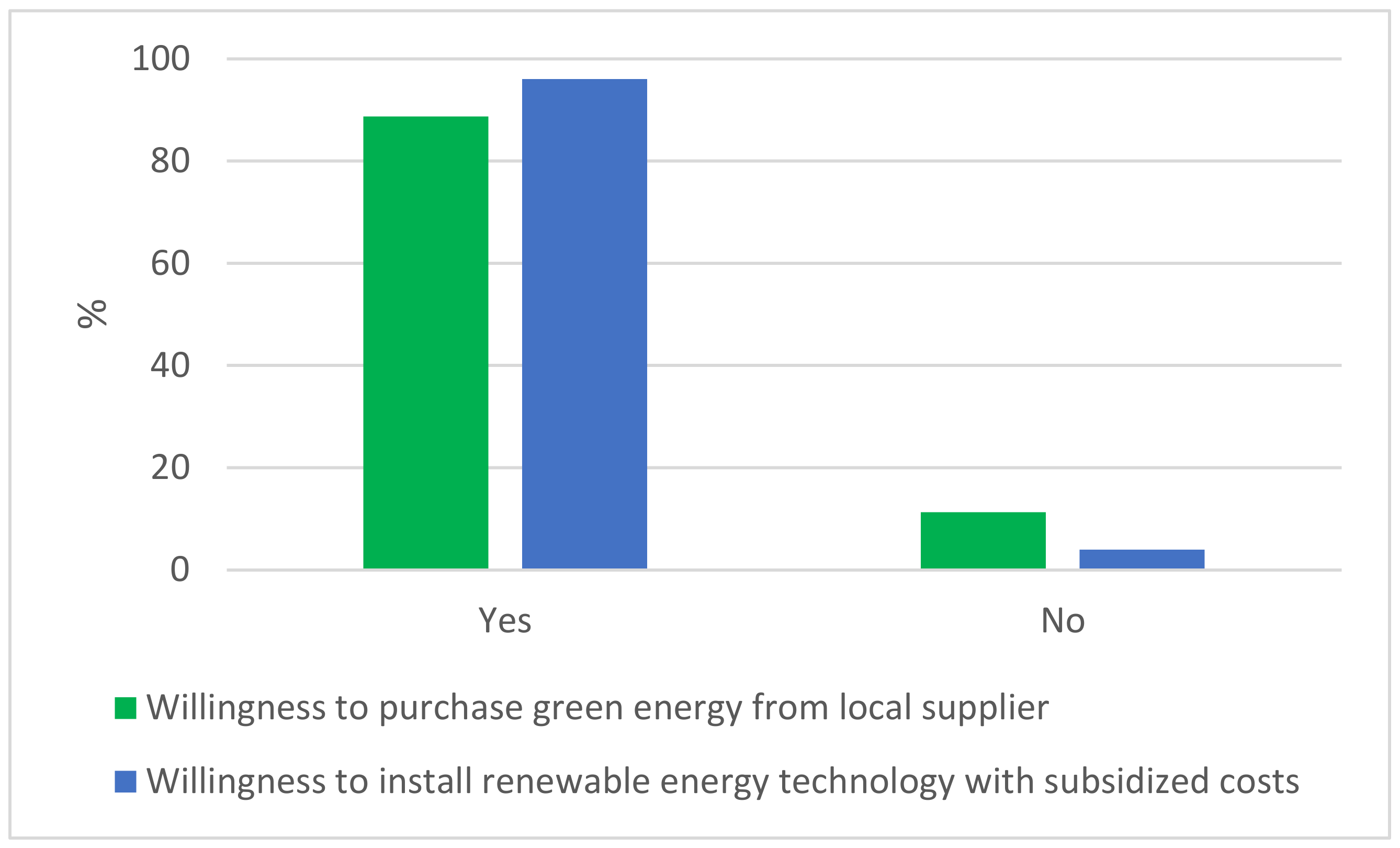
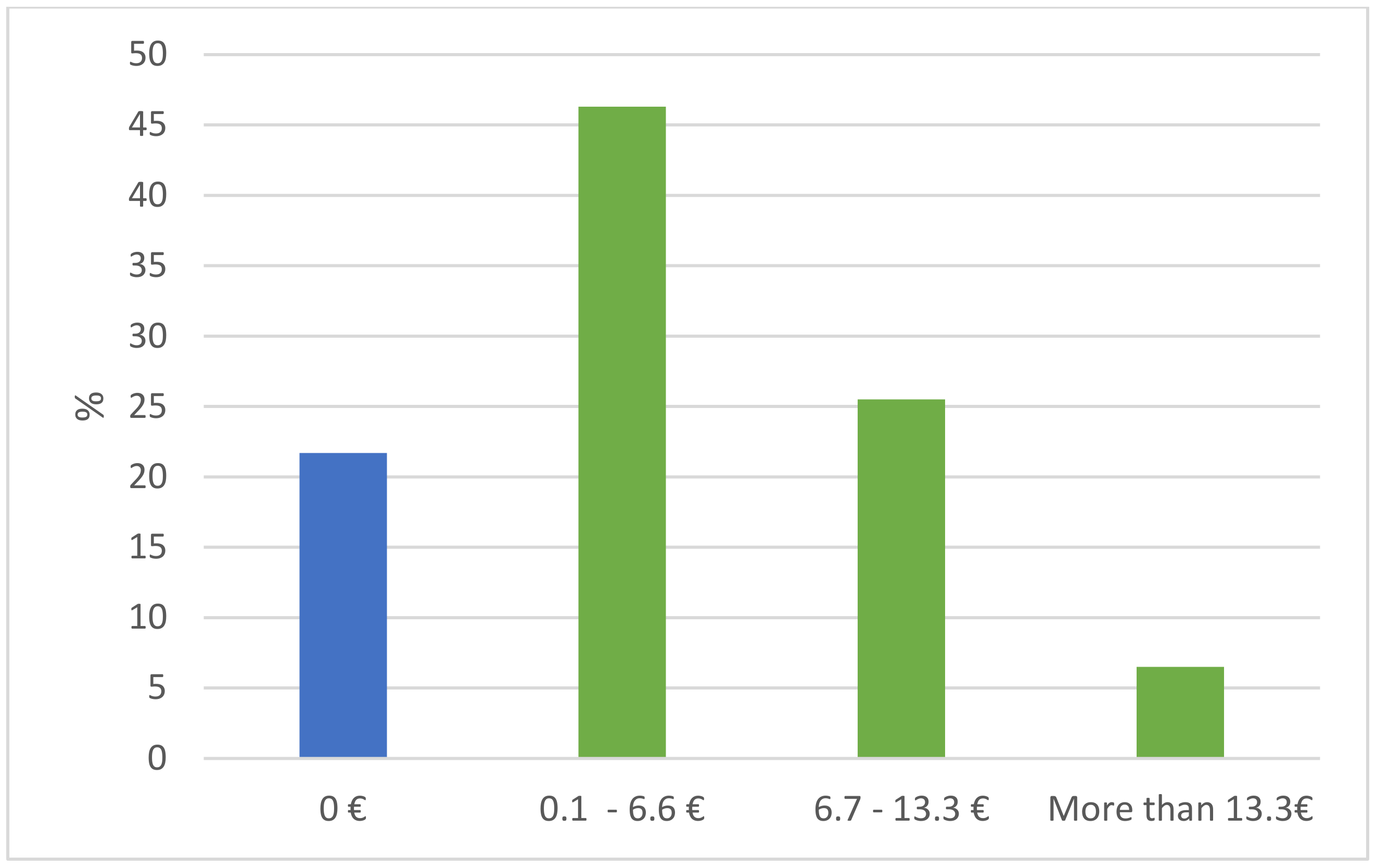
| Distribution of Sample, Percent | ||
|---|---|---|
| Region | Adriatic Croatia | 28.6 |
| Continental Croatia | 46.7 | |
| City of Zagreb | 24.7 | |
| Gender | Female | 67.3 |
| Male | 32.7 | |
| Age | 18–29 | 18.1 |
| 30–39 | 19.8 | |
| 40–49 | 25.4 | |
| 50–59 | 24.4 | |
| 60+ | 12.3 | |
| Education | Secondary education or lower | 13.7 |
| Tertiary education | 66.6 | |
| Post-graduate education | 14.1 | |
| Employment status | Employed | 80.3 |
| Student | 11.4 | |
| Other | 5.9 | |
| Type of residence facility | Multi-family building | 38.0 |
| House | 62.0 |
| Nothing at All | Poor | Average | Good | Excellent | |
|---|---|---|---|---|---|
| Wind power | 2.8 | 12.3 | 41.9 | 32.2 | 10.8 |
| Solar power | 1.1 | 7.8 | 34.5 | 41.4 | 15.3 |
| Hydropower | 4.1 | 20.4 | 32.5 | 31.5 | 11.5 |
| Geothermal energy | 11.2 | 35.6 | 27.4 | 19.4 | 8.3 |
| Biomass | 15.4 | 32.0 | 26.8 | 17.5 | 8.2 |
| Mean | Std. Deviation | |
|---|---|---|
| Economic growth | 4.51 | 1.05 |
| Job creation | 3.75 | 1.29 |
| Value of reduced air and water pollution | 4.67 | 0.95 |
| Reducing the dependence on energy imports | 4.61 | 1.04 |
| Reducing household energy expenses | 2.36 | 1.62 |
| Fighting against climate change | 4.67 | 0.97 |
| Health benefits | 4.61 | 0.94 |
| Indicator | Category | Willing to Pay, % | Unwilling to Pay, % | Pearson Chi-Squared Test/t-Test | p-Value |
|---|---|---|---|---|---|
| Fighting against climate change | Yes | 84.3 | 15.7 | 5.540 | 0.000 |
| No | 59.0 | 41.0 | |||
| Region | Adriatic Croatia | 77.5 | 22.5 | 6.062 | 0.048 |
| Continental Croatia | 83.2 | 16.8 | |||
| City of Zagreb | 71.0 | 29.0 | |||
| Benefits for climate change | No benefits | 20.0 | 80.0 | 46.976 | 0.000 |
| Neutral | 64.5 | 35.5 | |||
| Benefits | 82.4 | 17.6 | |||
| Benefits for households | No benefits | 22.6 | 77.4 | 65.843 | 0.000 |
| Neutral | 75.5 | 24.5 | |||
| Benefits | 85.4 | 14.6 | |||
| Benefits for local unit | No benefits | 29.2 | 70.8 | 43.262 | 0.000 |
| Neutral | 71.0 | 29.0 | |||
| Benefits | 84.2 | 15.8 | |||
| Age | 18–29 | 87.1 | 12.9 | 5.167 | 0.075 |
| 30–64 | 75.9 | 24.1 | |||
| 65+ | 86.4 | 13.6 | |||
| Gender | Female | 83.5 | 16.5 | 3.673 | 0.000 |
| Male | 68.1 | 31.9 | |||
| Willingness to purchase green energy from local supplier | Yes | 84.0 | 26.0 | 8.300 | 0.000 |
| No | 35.4 | 64.6 | |||
| Willingness to install renewable energy technology with subsidized costs | Yes | 79.5 | 20.5 | 2.619 | 0.009 |
| No | 47.1 | 52.9 |
Publisher’s Note: MDPI stays neutral with regard to jurisdictional claims in published maps and institutional affiliations. |
© 2021 by the authors. Licensee MDPI, Basel, Switzerland. This article is an open access article distributed under the terms and conditions of the Creative Commons Attribution (CC BY) license (https://creativecommons.org/licenses/by/4.0/).
Share and Cite
Slijepčević, S.; Kordej-De Villa, Ž. Public Attitudes toward Renewable Energy in Croatia. Energies 2021, 14, 8111. https://doi.org/10.3390/en14238111
Slijepčević S, Kordej-De Villa Ž. Public Attitudes toward Renewable Energy in Croatia. Energies. 2021; 14(23):8111. https://doi.org/10.3390/en14238111
Chicago/Turabian StyleSlijepčević, Sunčana, and Željka Kordej-De Villa. 2021. "Public Attitudes toward Renewable Energy in Croatia" Energies 14, no. 23: 8111. https://doi.org/10.3390/en14238111
APA StyleSlijepčević, S., & Kordej-De Villa, Ž. (2021). Public Attitudes toward Renewable Energy in Croatia. Energies, 14(23), 8111. https://doi.org/10.3390/en14238111






